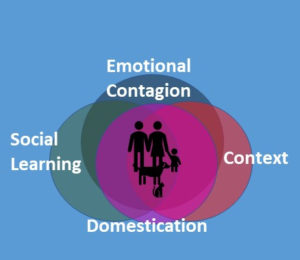 This week’s podcast considers the interaction of emotional contagion, social learning, domestication, and context as it affects our ability to communicate with our animals in a meaningful way. Sometimes those mechanisms that evolved over thousands of years to ensure the survival of the ancestors of today’s domestic dogs and cats may not work so well.
This week’s podcast considers the interaction of emotional contagion, social learning, domestication, and context as it affects our ability to communicate with our animals in a meaningful way. Sometimes those mechanisms that evolved over thousands of years to ensure the survival of the ancestors of today’s domestic dogs and cats may not work so well.
Related links:
Social Learning in Animals: Empirical Studies and Theoretical Models
In this country, “animal learning” often refers to how quickly animals can be trained to do something using a system of reward or punishment. Because of that, it’s easy to get the impression that this is how animals normally learn. But worldwide, the interest in social learning in animals as the norm is much greater.
Parent-offspring communication and learning begins on the baby animal’s–or human’s–day of birth. It’s a fascinating read and, if you can’t access it from your own sources, don’t forget your friendly neighborhood librarians. Libraries offer a lot more than books and even the smallest ones can access all sorts of things if you just ask.
For those interested in how this nursing-based system of communication and learning plays out in humans, this article considers the role communicating substances play in human mom-infant communication.
Podcast: Play in new window | Download
Subscribe: Apple Podcasts | Google Podcasts | RSS | More